Mallikarjun B R
FaceCraft4D: Animated 3D Facial Avatar Generation from a Single Image
Apr 21, 2025Abstract:We present a novel framework for generating high-quality, animatable 4D avatar from a single image. While recent advances have shown promising results in 4D avatar creation, existing methods either require extensive multiview data or struggle with shape accuracy and identity consistency. To address these limitations, we propose a comprehensive system that leverages shape, image, and video priors to create full-view, animatable avatars. Our approach first obtains initial coarse shape through 3D-GAN inversion. Then, it enhances multiview textures using depth-guided warping signals for cross-view consistency with the help of the image diffusion model. To handle expression animation, we incorporate a video prior with synchronized driving signals across viewpoints. We further introduce a Consistent-Inconsistent training to effectively handle data inconsistencies during 4D reconstruction. Experimental results demonstrate that our method achieves superior quality compared to the prior art, while maintaining consistency across different viewpoints and expressions.
Lite2Relight: 3D-aware Single Image Portrait Relighting
Jul 15, 2024
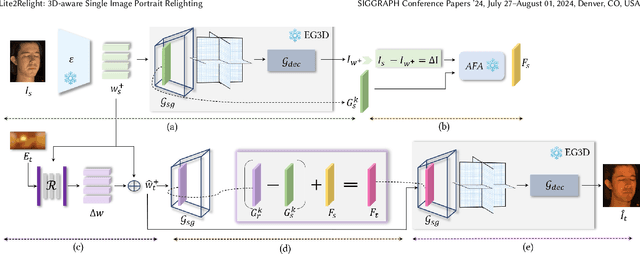
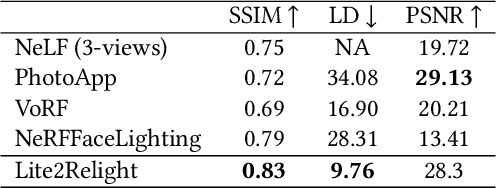
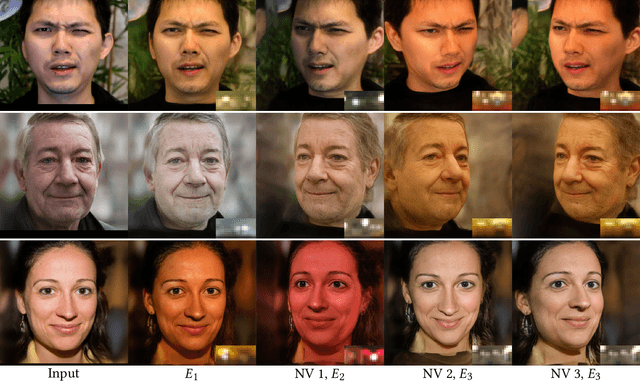
Abstract:Achieving photorealistic 3D view synthesis and relighting of human portraits is pivotal for advancing AR/VR applications. Existing methodologies in portrait relighting demonstrate substantial limitations in terms of generalization and 3D consistency, coupled with inaccuracies in physically realistic lighting and identity preservation. Furthermore, personalization from a single view is difficult to achieve and often requires multiview images during the testing phase or involves slow optimization processes. This paper introduces Lite2Relight, a novel technique that can predict 3D consistent head poses of portraits while performing physically plausible light editing at interactive speed. Our method uniquely extends the generative capabilities and efficient volumetric representation of EG3D, leveraging a lightstage dataset to implicitly disentangle face reflectance and perform relighting under target HDRI environment maps. By utilizing a pre-trained geometry-aware encoder and a feature alignment module, we map input images into a relightable 3D space, enhancing them with a strong face geometry and reflectance prior. Through extensive quantitative and qualitative evaluations, we show that our method outperforms the state-of-the-art methods in terms of efficacy, photorealism, and practical application. This includes producing 3D-consistent results of the full head, including hair, eyes, and expressions. Lite2Relight paves the way for large-scale adoption of photorealistic portrait editing in various domains, offering a robust, interactive solution to a previously constrained problem. Project page: https://vcai.mpi-inf.mpg.de/projects/Lite2Relight/
AvatarStudio: Text-driven Editing of 3D Dynamic Human Head Avatars
Jun 02, 2023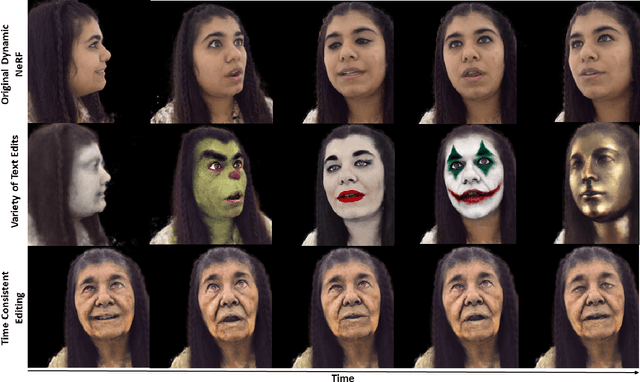

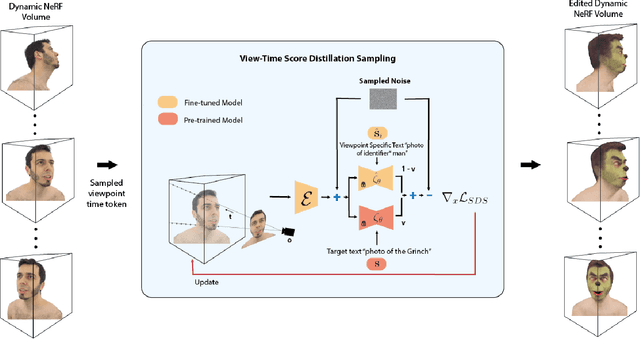
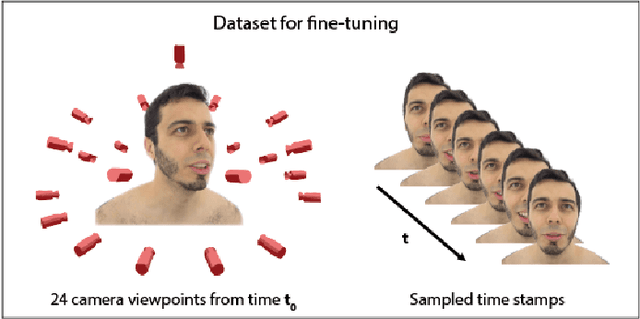
Abstract:Capturing and editing full head performances enables the creation of virtual characters with various applications such as extended reality and media production. The past few years witnessed a steep rise in the photorealism of human head avatars. Such avatars can be controlled through different input data modalities, including RGB, audio, depth, IMUs and others. While these data modalities provide effective means of control, they mostly focus on editing the head movements such as the facial expressions, head pose and/or camera viewpoint. In this paper, we propose AvatarStudio, a text-based method for editing the appearance of a dynamic full head avatar. Our approach builds on existing work to capture dynamic performances of human heads using neural radiance field (NeRF) and edits this representation with a text-to-image diffusion model. Specifically, we introduce an optimization strategy for incorporating multiple keyframes representing different camera viewpoints and time stamps of a video performance into a single diffusion model. Using this personalized diffusion model, we edit the dynamic NeRF by introducing view-and-time-aware Score Distillation Sampling (VT-SDS) following a model-based guidance approach. Our method edits the full head in a canonical space, and then propagates these edits to remaining time steps via a pretrained deformation network. We evaluate our method visually and numerically via a user study, and results show that our method outperforms existing approaches. Our experiments validate the design choices of our method and highlight that our edits are genuine, personalized, as well as 3D- and time-consistent.
GVP: Generative Volumetric Primitives
Mar 31, 2023Abstract:Advances in 3D-aware generative models have pushed the boundary of image synthesis with explicit camera control. To achieve high-resolution image synthesis, several attempts have been made to design efficient generators, such as hybrid architectures with both 3D and 2D components. However, such a design compromises multiview consistency, and the design of a pure 3D generator with high resolution is still an open problem. In this work, we present Generative Volumetric Primitives (GVP), the first pure 3D generative model that can sample and render 512-resolution images in real-time. GVP jointly models a number of volumetric primitives and their spatial information, both of which can be efficiently generated via a 2D convolutional network. The mixture of these primitives naturally captures the sparsity and correspondence in the 3D volume. The training of such a generator with a high degree of freedom is made possible through a knowledge distillation technique. Experiments on several datasets demonstrate superior efficiency and 3D consistency of GVP over the state-of-the-art.
HQ3DAvatar: High Quality Controllable 3D Head Avatar
Mar 25, 2023Abstract:Multi-view volumetric rendering techniques have recently shown great potential in modeling and synthesizing high-quality head avatars. A common approach to capture full head dynamic performances is to track the underlying geometry using a mesh-based template or 3D cube-based graphics primitives. While these model-based approaches achieve promising results, they often fail to learn complex geometric details such as the mouth interior, hair, and topological changes over time. This paper presents a novel approach to building highly photorealistic digital head avatars. Our method learns a canonical space via an implicit function parameterized by a neural network. It leverages multiresolution hash encoding in the learned feature space, allowing for high-quality, faster training and high-resolution rendering. At test time, our method is driven by a monocular RGB video. Here, an image encoder extracts face-specific features that also condition the learnable canonical space. This encourages deformation-dependent texture variations during training. We also propose a novel optical flow based loss that ensures correspondences in the learned canonical space, thus encouraging artifact-free and temporally consistent renderings. We show results on challenging facial expressions and show free-viewpoint renderings at interactive real-time rates for medium image resolutions. Our method outperforms all existing approaches, both visually and numerically. We will release our multiple-identity dataset to encourage further research. Our Project page is available at: https://vcai.mpi-inf.mpg.de/projects/HQ3DAvatar/
State of the Art in Dense Monocular Non-Rigid 3D Reconstruction
Oct 27, 2022Abstract:3D reconstruction of deformable (or non-rigid) scenes from a set of monocular 2D image observations is a long-standing and actively researched area of computer vision and graphics. It is an ill-posed inverse problem, since--without additional prior assumptions--it permits infinitely many solutions leading to accurate projection to the input 2D images. Non-rigid reconstruction is a foundational building block for downstream applications like robotics, AR/VR, or visual content creation. The key advantage of using monocular cameras is their omnipresence and availability to the end users as well as their ease of use compared to more sophisticated camera set-ups such as stereo or multi-view systems. This survey focuses on state-of-the-art methods for dense non-rigid 3D reconstruction of various deformable objects and composite scenes from monocular videos or sets of monocular views. It reviews the fundamentals of 3D reconstruction and deformation modeling from 2D image observations. We then start from general methods--that handle arbitrary scenes and make only a few prior assumptions--and proceed towards techniques making stronger assumptions about the observed objects and types of deformations (e.g. human faces, bodies, hands, and animals). A significant part of this STAR is also devoted to classification and a high-level comparison of the methods, as well as an overview of the datasets for training and evaluation of the discussed techniques. We conclude by discussing open challenges in the field and the social aspects associated with the usage of the reviewed methods.
Disentangled3D: Learning a 3D Generative Model with Disentangled Geometry and Appearance from Monocular Images
Mar 29, 2022



Abstract:Learning 3D generative models from a dataset of monocular images enables self-supervised 3D reasoning and controllable synthesis. State-of-the-art 3D generative models are GANs which use neural 3D volumetric representations for synthesis. Images are synthesized by rendering the volumes from a given camera. These models can disentangle the 3D scene from the camera viewpoint in any generated image. However, most models do not disentangle other factors of image formation, such as geometry and appearance. In this paper, we design a 3D GAN which can learn a disentangled model of objects, just from monocular observations. Our model can disentangle the geometry and appearance variations in the scene, i.e., we can independently sample from the geometry and appearance spaces of the generative model. This is achieved using a novel non-rigid deformable scene formulation. A 3D volume which represents an object instance is computed as a non-rigidly deformed canonical 3D volume. Our method learns the canonical volume, as well as its deformations, jointly during training. This formulation also helps us improve the disentanglement between the 3D scene and the camera viewpoints using a novel pose regularization loss defined on the 3D deformation field. In addition, we further model the inverse deformations, enabling the computation of dense correspondences between images generated by our model. Finally, we design an approach to embed real images into the latent space of our disentangled generative model, enabling editing of real images.
Efficient and Differentiable Shadow Computation for Inverse Problems
Apr 01, 2021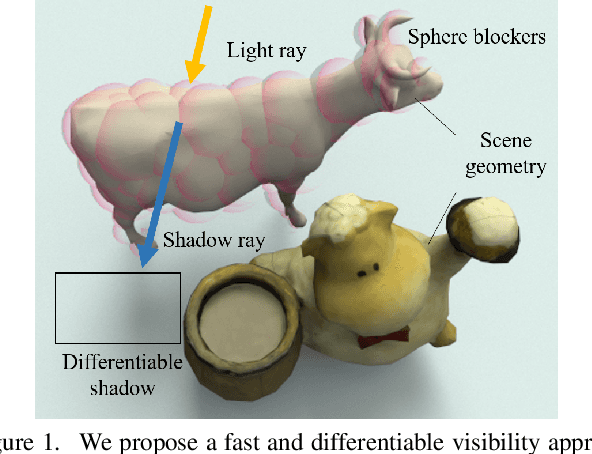
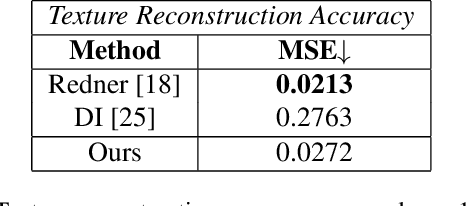

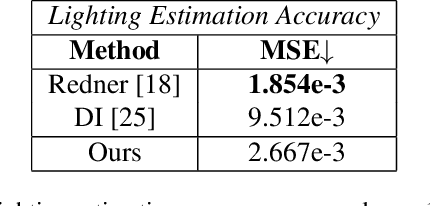
Abstract:Differentiable rendering has received increasing interest for image-based inverse problems. It can benefit traditional optimization-based solutions to inverse problems, but also allows for self-supervision of learning-based approaches for which training data with ground truth annotation is hard to obtain. However, existing differentiable renderers either do not model visibility of the light sources from the different points in the scene, responsible for shadows in the images, or are too slow for being used to train deep architectures over thousands of iterations. To this end, we propose an accurate yet efficient approach for differentiable visibility and soft shadow computation. Our approach is based on the spherical harmonics approximations of the scene illumination and visibility, where the occluding surface is approximated with spheres. This allows for a significantly more efficient shadow computation compared to methods based on ray tracing. As our formulation is differentiable, it can be used to solve inverse problems such as texture, illumination, rigid pose, and geometric deformation recovery from images using analysis-by-synthesis optimization.
PhotoApp: Photorealistic Appearance Editing of Head Portraits
Mar 13, 2021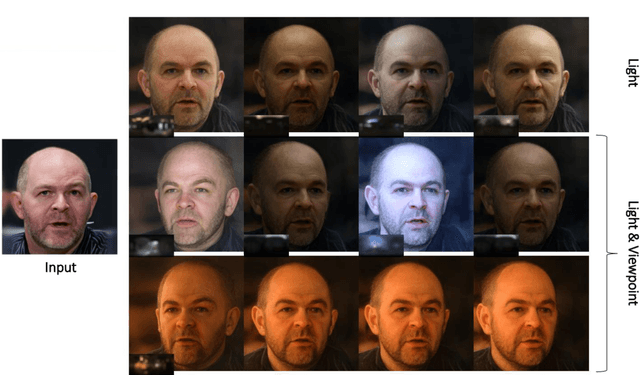
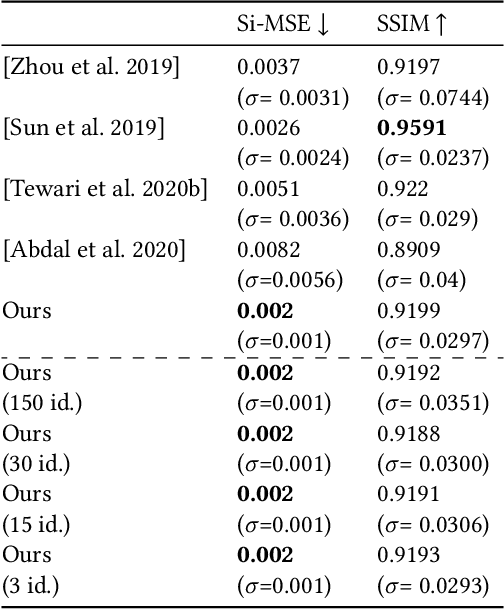
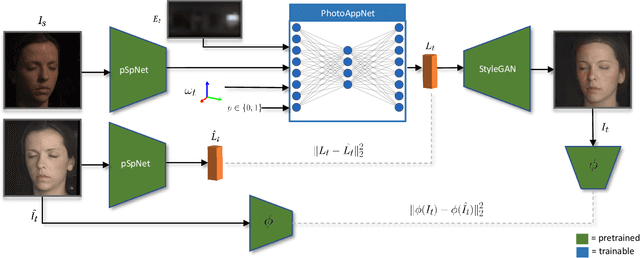
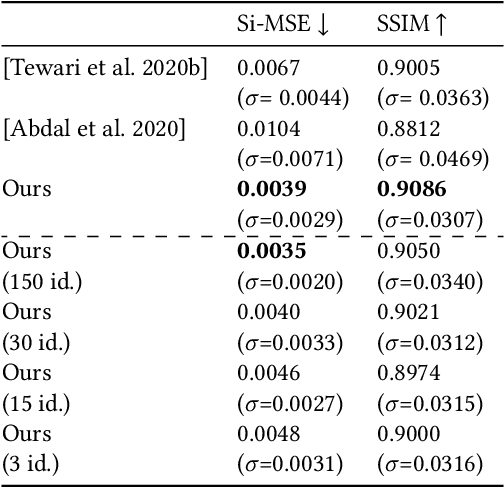
Abstract:Photorealistic editing of portraits is a challenging task as humans are very sensitive to inconsistencies in faces. We present an approach for high-quality intuitive editing of the camera viewpoint and scene illumination in a portrait image. This requires our method to capture and control the full reflectance field of the person in the image. Most editing approaches rely on supervised learning using training data captured with setups such as light and camera stages. Such datasets are expensive to acquire, not readily available and do not capture all the rich variations of in-the-wild portrait images. In addition, most supervised approaches only focus on relighting, and do not allow camera viewpoint editing. Thus, they only capture and control a subset of the reflectance field. Recently, portrait editing has been demonstrated by operating in the generative model space of StyleGAN. While such approaches do not require direct supervision, there is a significant loss of quality when compared to the supervised approaches. In this paper, we present a method which learns from limited supervised training data. The training images only include people in a fixed neutral expression with eyes closed, without much hair or background variations. Each person is captured under 150 one-light-at-a-time conditions and under 8 camera poses. Instead of training directly in the image space, we design a supervised problem which learns transformations in the latent space of StyleGAN. This combines the best of supervised learning and generative adversarial modeling. We show that the StyleGAN prior allows for generalisation to different expressions, hairstyles and backgrounds. This produces high-quality photorealistic results for in-the-wild images and significantly outperforms existing methods. Our approach can edit the illumination and pose simultaneously, and runs at interactive rates.
Learning Complete 3D Morphable Face Models from Images and Videos
Oct 04, 2020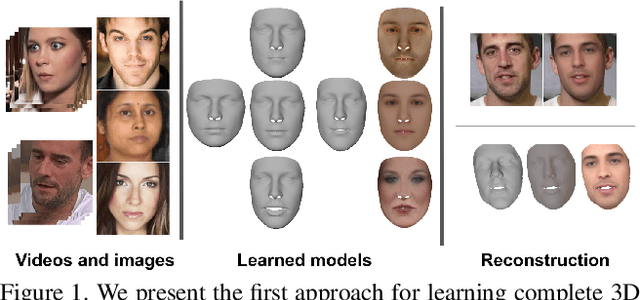

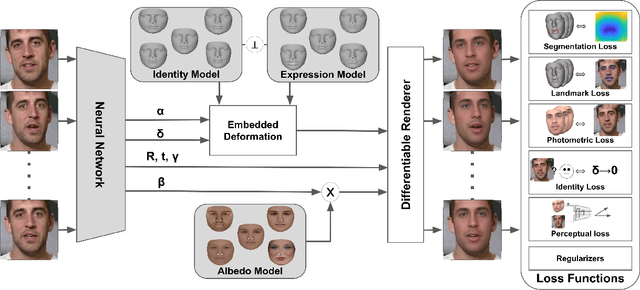

Abstract:Most 3D face reconstruction methods rely on 3D morphable models, which disentangle the space of facial deformations into identity geometry, expressions and skin reflectance. These models are typically learned from a limited number of 3D scans and thus do not generalize well across different identities and expressions. We present the first approach to learn complete 3D models of face identity geometry, albedo and expression just from images and videos. The virtually endless collection of such data, in combination with our self-supervised learning-based approach allows for learning face models that generalize beyond the span of existing approaches. Our network design and loss functions ensure a disentangled parameterization of not only identity and albedo, but also, for the first time, an expression basis. Our method also allows for in-the-wild monocular reconstruction at test time. We show that our learned models better generalize and lead to higher quality image-based reconstructions than existing approaches.
 Add to Chrome
Add to Chrome Add to Firefox
Add to Firefox Add to Edge
Add to Edge